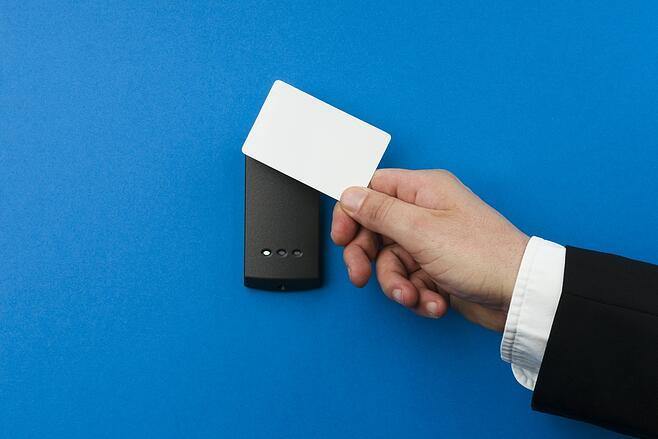Archaic proximity cards are losing the hegemony to retrofit & identity-based mobile access control systems. Enterprises transitioning to modern-day access control systems are reaching tangible benefits downstream.
Proximity cards have been the primary access mode for many businesses and organizations for years. However, with the advent of mobile technology, these cards are starting to lose their hegemony. Mobile access allows employees to enter buildings and other secure areas with just their phones, which is much more convenient than carrying a separate card. There are several efficiency advantages that come along with mobile access. These benefits are spelling the nemesis of proximity cards.
How have Proximity Cards ruled the access governance policies of organizations?
The answer to this question is straightforward; because they were the only option available until now. Proximity cards or key fobs are physical devices that use radio-frequency identification (RFID) technology. This technology was developed in the 1970s and has been used for various applications such as contactless payments, public transport ticketing, and access control.
Why access cards are losing their prominence
Access card users need to be careful with them. These simple-looking devices come with the following risks:
- Risk of identity theft: A major concern with proximity cards is that they can be used to steal personal information. If someone steals an employee’s card, they can gain access to all the data on the card, including the employee’s name, address, and date of birth.
- Risk of getting stolen: Proximity cards can be stolen, and their data can be sold or misused. This is a serious security concern for businesses and organisations that use these cards for access control.
- Risk of getting lost: Another issue with access cards is that they can be easily lost or misplaced. If an employee loses their card, they have to go through the hassle of getting a new one.
- Risk of getting damaged: Prox cards’ chip or antenna can also be damaged, rendering them useless. If an employee’s card or chip is damaged, then they would again have to go through a lengthy process to again get a new one from the organization. Moreover, prox cards are also vulnerable to electrostatic discharge. (Also Read : Physical Security Vs Cybersecurity)
Alternatives to Proximity Cards
Table 1 : Alternatives to proximity cards
Access Control Alternative | Description |
Mobile access control systems | Utilizes a smartphone app to grant access |
Biometric access control | Uses fingerprints, facial recognition, or other biometric data to grant access |
Smart cards | Similar to Proximity Cards, but with embedded microchips and added security features |
Key fobs | Small, portable devices used in place of Proximity Cards, often more durable |
PIN code access | Requires users to enter a personal identification number (PIN) to gain access |
Prox cards, which have long been used as the primary form of access control in buildings and facilities, are now being replaced by mobile access control systems. These new systems take benefit of advances in technology to provide faster and more efficient security for businesses and organizations.
One of the key benefits of mobile access control is that it obviates the need for physical cards and instead uses a simple smartphone app to grant access to authorized individuals. With this system, people no longer have to carry around bulky keys or remember long card numbers; all they need is their phone.
Additionally, mobile access control enables administrators to easily manage users and revoke access rights at any time. Overall, this innovative new approach to security ensures efficient, convenient protection for buildings of all sizes.
Benefits of Mobile Access over proximity cards
There are many benefits to using mobile access over proximity cards. Mobile access is more convenient, efficient, and secure. If you want to upgrade your access control system, consider switching to mobile access.
- Eliminates the need for a separate card: Mobile access ends the need for a separate card. It is convenient for the employees and cost-saving for the organization. Modern-day physical-identity software providers offer fast and efficient ways to onboard and off-board employees without the need for an access card.
- Reduces the risk of loss or theft: Mobile access reduces the risk of loss or theft. If an employee loses their phone, they can deactivate their account and cancel their access. Future forward mobile access also allows for remote access. This feature brings convenience to the employees who work remotely or travel often.
- Improves security: Mobile access enhances security. With mobile access, businesses and organizations can set up identity-based single sign-on. It means that an employee will need their phone to gain access, reducing the cases of unauthorized access.
- Reduces the risk of fraud: Mobile access also reduces the risk of fraud. With mobile access, businesses and organizations can track employee activity. It helps to prevent fraud and misuse of company resources.
- Makes it easy to revoke access: Mobile access also makes it easy to revoke access. If an employee is terminated, their access can be immediately revoked. It is much more efficient than having to cancel their proximity card.
Table 2: Major differences between Mobile Access Control & Proximity Cards
Benefits | Mobile Access | Proximity Cards |
Convenience | Employees do not need to carry a separate card. | Employees need to carry a separate card. |
Onboarding & Offboarding Employees | fast and efficient. | may take more time and resources. |
Remote Access | Remote access is possible, which is convenient for remote workers. | Remote access may not be available. |
Security | Identity-based single sign-on reduces the risk of unauthorized access. | Less secure than mobile access. |
Track Employees | Can track employee activity to prevent fraud and misuse. | More difficult to track employee activity. |
Risk of loss/theft | Employees can easily deactivate their accountsaccount if they lose their phone. | If lost or stolen, the card can be used by anyone who finds it. |
Lost or Stolen | Remote access can be disabled if phone is lost or stolen. | If lost or stolen, the card must be cancelled and replaced. |
Revoking access | Access can be immediately revoked when an employee is terminated. | Revoking access may take more time and resources. |
Cancellation procedure | More efficient than cancelling a proximity card. | Cancelling a proximity card may take longer. |
Identity-Based Access Control is the name of the game
Smart organizations are replacing their antiquated access control system with retrofit access control systems. This is because retrofit and identity-based access control systems offer several advantages over traditional systems that use pin-pads, access badges, and fingerprint readers. They harness the power of multi-modal authentication software to deliver frictionless and accurate access to the modern-day workforce.
A retrofit access control system doesn’t require a physical key. It is more convenient for employees and helps to reduce organizational costs. The most important aspect is that the retrofit access control system does not necessitate the replacement of antiquated systems. Organizations can have their traditional systems transformed into retrofit access control solutions by following a few simple steps.
Transitioning to Retrofit Access Control Solutions is easy
OLOID’s retrofit access solutions don’t require a heavy infrastructural setup. You can quickly and easily install a retrofit kit on your existing doors without any hardware or wiring replacement. This way, you can experience the latest access control technology without having to replace your current system.
Organizations don’t have to replace the entire setup as OLOID’s retrofit solutions are compatible with the majority of the existing access control systems.
Conclusion
Retrofit and identity-based access control systems offer many advantages over traditional proximity card systems like pin-pads, access badges, and fingerprint readers. These solutions offer the ease of self-service. Companies can transition to retrofit access control solutions quickly and easily. The solutions are easy to install without any professional help. They are more convenient, efficient, and secure. If you are looking for a smart access control solution and give your team freedom from proximity cards, you can reach out to our experts.
FAQs
Can proximity cards be hacked?
While proximity cards are generally secure, they can be vulnerable to hacking if not properly secured or if outdated technology is used. This is why it is important to use up-to-date security measures and protocols.
What are the benefits of retrofitting an access control system?
Retrofitting an access control system can provide several benefits, such as reducing the cost and disruption of a full system replacement, improving security, and enabling the integration of newer technologies.
How does mobile-based access control work?
Mobile-based access control works by using a mobile device, such as a smartphone or tablet, to authenticate a user’s identity and grant access to secure areas. This can be done using various technologies, such as Bluetooth, NFC, or Wi-Fi.
What are some examples of industries that use proximity card or mobile-based access control systems?
Industries that commonly use these types of access control systems include healthcare, education, government, manufacturing, and retail, among others.
What is retrofit access control?
Retrofit access control is a security system that allows for the upgrade of existing access control systems by integrating new technology, such as mobile or proximity card access, with the existing infrastructure.




